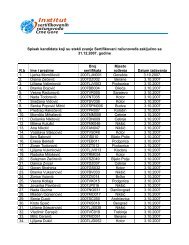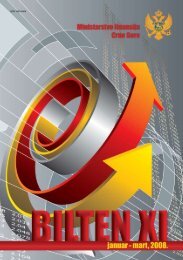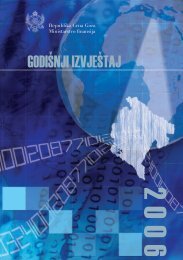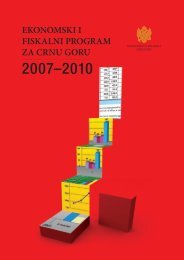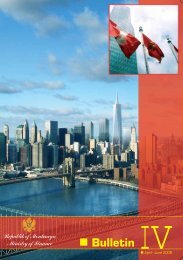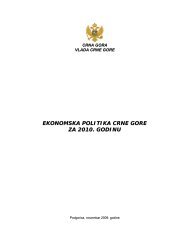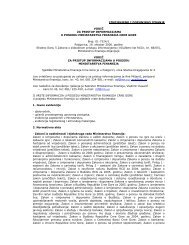Republic of Montenegro: Public Expenditure and ... - Vlada Crne Gore
Republic of Montenegro: Public Expenditure and ... - Vlada Crne Gore
Republic of Montenegro: Public Expenditure and ... - Vlada Crne Gore
You also want an ePaper? Increase the reach of your titles
YUMPU automatically turns print PDFs into web optimized ePapers that Google loves.
Chapter 1: The Economic <strong>and</strong> Institutional Context 3<br />
B. MACROECONOMIC DEVELOPMENTS<br />
1.10 Since 1997, <strong>Montenegro</strong>, with the support <strong>of</strong> the international community, 3 has been<br />
engaged in a long series <strong>of</strong> macroeconomic stabilization, <strong>and</strong> market-oriented structural<br />
reforms. It has implemented currency <strong>and</strong> fiscal policy reforms, <strong>and</strong> in parallel, a number <strong>of</strong><br />
structural reforms, including price <strong>and</strong> trade liberalization, privatization, public administration<br />
reform, financial sector reform, <strong>and</strong> labor market <strong>and</strong> business environment reforms. The<br />
Government’s recently updated Economic Reform Program for 2005-2007, which lays out what<br />
economic reforms remain to be done over the coming years.<br />
1.11 The macroeconomic <strong>and</strong> structural reforms have yielded modest economic recovery<br />
<strong>and</strong> transition. Over the last five years, real GDP grew by an average <strong>of</strong> about 2 percent per<br />
year; inflation dropped from 24.8 percent at the end <strong>of</strong> 2000 to 1.8 percent at the end <strong>of</strong> 2005;<br />
<strong>Montenegro</strong>’s consolidated budget deficit has been reduced; its current account deficit, although<br />
still high, is improving; <strong>and</strong>, its principal human welfare indicators such as poverty, life<br />
expectancy, <strong>and</strong> adult literacy have remained moderate <strong>and</strong> stable.<br />
Growth <strong>and</strong> Employment<br />
1.12 In 2005, real GDP is estimated to have grown by about 4.1 percent (Table 1.1). 4 This<br />
is higher than the average annual real GDP growth witnessed over 2000-2004 (about 2 percent).<br />
On the supply side, growth in industrial production was negative (-1.9 percent) mainly on<br />
account <strong>of</strong> reduced economic activities <strong>of</strong> the coal mining company, which in turn adversely<br />
affected the thermal power plant operation, <strong>and</strong> steel production. However, tourism has shown<br />
significant growth, with tourist arrivals increasing by 16 percent in 2005 (<strong>and</strong> the number <strong>of</strong><br />
foreign tourists 5 increasing from 25 percent to 33 percent in total tourist arrivals). On the dem<strong>and</strong><br />
side, FDI increased (mostly through Telecom <strong>and</strong> KAP privatization) <strong>and</strong> a significant credit<br />
growth fueled household consumption.<br />
1.13 While employment recovery seems underway since 2004, unemployment still<br />
remains high. After declining by about 7 percent over 1998-2004, employment seems to be<br />
recovering. The “<strong>of</strong>ficial” data from the Employment Bureau show that employment increased<br />
<strong>and</strong> unemployment declined in 2005 (but the more reliable labor force survey data is not yet<br />
available). Yet unemployment remains high. Long-term unemployment is widely prevalent, as<br />
more than one-fifth <strong>of</strong> the registered unemployed are on the roster for more than eight years. The<br />
persistence <strong>of</strong> high unemployment even after more than a decade <strong>of</strong> transition suggests that the<br />
new private sector, comprised <strong>of</strong> small firms, has not yet developed the critical mass to generate<br />
enough jobs to <strong>of</strong>fset the job losses in the old public sector.<br />
3 Main donors in <strong>Montenegro</strong> include USAID, EAR, World Bank, UNDP.<br />
4 This is an agreed estimate <strong>of</strong> the Development Secretariat, the Ministry <strong>of</strong> Finance, <strong>and</strong> the Institute for Strategic<br />
Studies <strong>and</strong> Prognoses. The <strong>Republic</strong> <strong>of</strong> <strong>Montenegro</strong> lacks up to date national accounts statistics. MONSTAT, the<br />
republican statistical agency, is still working to produce national accounts statistics for 2003. The lack <strong>of</strong> national<br />
accounts data—in particular the supply <strong>and</strong> dem<strong>and</strong> side breakdown <strong>of</strong> GDP--poses a significant challenge in<br />
undertaking detailed analysis the composition <strong>of</strong> growth in <strong>Montenegro</strong>.<br />
5 Domestic tourists include those from Serbia.




